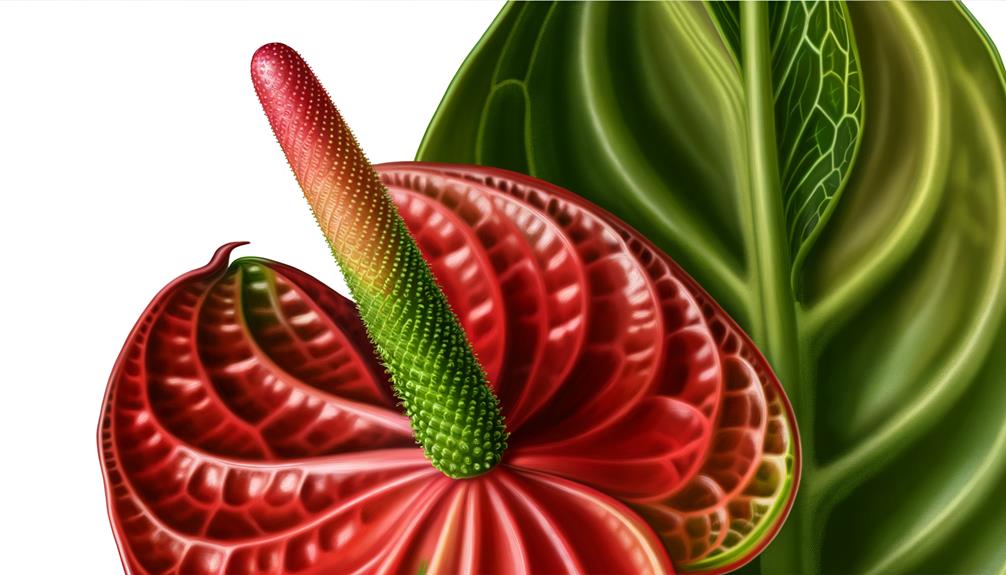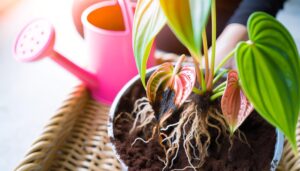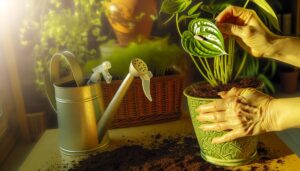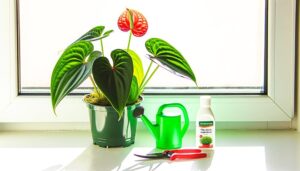How to Identify Anthurium Flower Parts
To identify Anthurium flower parts, start with the spadix, a central spike composed of tiny male and female flowers. Surrounding the spadix is the colorful spathe, a modified leaf that protects and supports it.
Notice the heart-shaped, glossy leaves, essential for photosynthesis, growing on thick, fleshy petioles. Below ground, or sometimes above, the roots absorb nutrients and water, aided by a velamen layer for moisture retention.
Each part, from spadix to roots, serves a distinct purpose. Continue discovering how these elements interact and contribute to the plant's overall health and beauty.

Key Takeaways
- The spathe is a modified leaf, often colorful, that protects and supports the spadix.
- The spadix is a central spike composed of tiny, closely packed flowers, with male and female florets arranged differently.
- Heart-shaped foliage leaves are glossy, enhancing light absorption for photosynthesis.
- The stem, or petiole, is thick and fleshy, providing structural support to the plant.
- Roots, including aerial roots with velamen, are designed for water and nutrient absorption, often containing chlorophyll for photosynthesis.
Overview of Anthurium Anatomy
Understanding the anatomy of an Anthurium flower is essential for identifying its various parts and their functions.
Begin by observing the spadix, the cylindrical structure at the flower's center. It's densely packed with tiny flowers that produce pollen.
Surrounding the spadix, you'll find the spathe, a modified leaf that resembles a petal. The spathe's primary role is to attract pollinators.
Notice the glossy, heart-shaped leaves at the base; these are the foliage leaves, providing photosynthesis.
The stem, or petiole, supports the leaves and spathe, ensuring nutrient transport.
Don't overlook the roots, which anchor the plant and absorb water and minerals.
Each part plays a critical role in the Anthurium's life cycle and reproduction.
The Spathe
You'll notice the spathe is a unique, leaf-like structure that distinguishes the anthurium.
It often exhibits vibrant colors ranging from deep reds to bright whites, contributing to the flower's visual appeal.
Its texture can vary from smooth to slightly leathery, providing additional tactile interest.
Unique Leaf-Like Structure
The spathe, often mistaken for a petal, is a altered leaf that serves to shield and sometimes allure pollinators to the flowering arrangement of the anthurium. It unfurls around the spadix, the central spike where the tiny true flowers cluster. Understanding the spathe's role is essential for proper identification and care of anthuriums.
| Feature | Function | Description |
|---|---|---|
| Altered Leaf | Protection | Encases the spadix, shielding it from harm. |
| Attractant | Pollinator Attraction | Often brightly colored to lure pollinators. |
| Arrangement | Supportive | Provides structural integrity to the floral display. |
Color and Texture
With its vibrant hues and varying textures, the spathe of an anthurium plays an essential role in distinguishing different species and cultivars. You'll find spathes ranging from deep reds and pinks to whites, greens, and even purples.
The coloration isn't just for show; it attracts pollinators and protects the inflorescence. Texture-wise, spathes can be glossy, matte, or even slightly ribbed. Glossy spathes often feel waxy, while matte ones have a softer, velvety touch. Ribbed spathes feature subtle ridges that add depth.
Recognizing these variations helps you identify specific anthurium types more accurately. Pay attention to both color and texture for a thorough understanding of each plant's unique characteristics.
The Spadix
You'll find the spadix at the center of the Anthurium flower, a cylindrical structure composed of densely packed, tiny flowers. It often displays a range of colors from white to deep red, with a texture that can be either smooth or slightly bumpy.
The spadix plays an essential role in reproduction, housing both male and female flowers that facilitate pollination.
Structure and Function
At the heart of the anthurium flower, the spadix stands as a central structure, composed of numerous tiny flowers tightly packed together. These flowers, called florets, are arranged in a spiral pattern along the spadix. Each floret consists of both male and female reproductive organs, facilitating efficient pollination.
The spadix's role is essential for the plant's reproductive process, as it produces pollen and receives it to form seeds. You'll notice that the spadix is often surrounded by a spathe, a modified leaf that protects and highlights the spadix. The spadix can vary in shape and size, adapting to different pollinators, ensuring the flower's successful reproduction.
Understanding the spadix's structure and function is vital to appreciating anthurium's unique botanical characteristics.
Color and Texture
Examining the spadix reveals a fascinating array of colors and textures that vary greatly depending on the anthurium species. You'll notice that the spadix can exhibit a spectrum ranging from white to deep maroon. Texture also varies; some spadices are smooth, while others might be granular or even bumpy. These characteristics can help you distinguish between species and understand more about their pollination strategies.
Here's a detailed table to illustrate the variety:
| Species | Color Range | Texture |
|---|---|---|
| Anthurium andraeanum | White to Red | Smooth |
| Anthurium scherzerianum | Orange to Red | Granular |
| Anthurium crystallinum | Cream to Light Green | Bumpy |
| Anthurium clarinervium | Green to Yellow | Smooth to Bumpy |
These variations in the spadix are essential for identifying specific anthurium species.
Leaves and Stems
The leaves of the Anthurium plant are typically large, leathery, and heart-shaped, providing essential support and photosynthesis functions. You'll notice their glossy surface, which helps to maximize light absorption. These leaves are often dark green, but some varieties exhibit variegation.
They're attached to robust stems that can be either erect or trailing, depending on the species. The stems are thick and fleshy, designed to store water and nutrients. They also exhibit a characteristic jointed appearance, where leaves and aerial roots emerge. The internodes, the segments between leaf attachments, vary in length but are usually short, giving the plant a compact look.
Understanding these features helps in identifying and caring for your Anthurium properly.
Roots
Roots of the Anthurium plant are thick, fleshy, and designed to absorb both water and nutrients efficiently. You'll find they exhibit a robust structure, often growing above the soil surface, known as aerial roots. These roots have velamen, a spongy tissue that aids in rapid water absorption. They also contain chlorophyll, enabling photosynthesis, which contributes to the plant's overall health.
When examining the roots, look for a white or light green coloration, indicating they're healthy. It's important to ensure the roots remain moist but not waterlogged, preventing rot. Anthurium roots thrive in well-draining soil or growing mediums such as orchid bark or sphagnum moss, supporting their epiphytic nature. Proper root care is vital for a flourishing Anthurium.
Identifying Flower Growth Stages
Understanding the flower growth stages of an Anthurium involves identifying key phases from bud formation to full bloom.
First, observe the initial bud stage, where a tightly closed spathe begins to form.
Next, in the pre-bloom stage, the spathe gradually unfurls, revealing the spadix at its center.
During full bloom, the spathe is fully open, displaying its vibrant color, and the spadix becomes prominent with tiny flowers.
Anthuriums can have sequential blooms, meaning new buds may form as older flowers fade.
Monitor the spathe for color changes, which indicate aging.
Common Varieties
Among the diverse Anthurium genus, you'll find several common varieties distinguished by their unique spathe colors, spadix shapes, and foliage patterns. These variations can help you identify the specific type of Anthurium you are examining.
| Variety | Characteristics |
|---|---|
| Anthurium andreanum | Large, heart-shaped spathes in colors like red, pink, or white; straight, yellow spadix |
| Anthurium scherzerianum | Curved spadix with twisted spathes, typically red or orange |
| Anthurium crystallinum | Velvety, dark green leaves with pronounced white veins; smaller, white spathes |
Anthurium andreanum, often called the "Flamingo Flower," is known for its vibrant, glossy spathes. Anthurium scherzerianum features a unique curled spadix and bold spathe colors. Anthurium crystallinum stands out with its dramatic foliage and delicate spathe. Identifying these characteristics will help you distinguish among the varieties.
Care Tips for Anthuriums
To keep your Anthuriums thriving, make sure they receive bright, indirect light and maintain a consistently warm and humid environment. Proper care ensures optimal growth and vibrant blooms.
Follow these essential care tips:
- Watering: Keep the soil consistently moist but not saturated. Use well-draining soil to prevent root rot.
- Humidity: Maintain high moisture levels around 60-80%. Use a humidifier or place the plant on a tray filled with pebbles and water.
- Fertilization: Feed your Anthuriums every 6-8 weeks with a balanced, water-soluble fertilizer. Reduce feeding in winter.
Conclusion
Understanding the anthurium's anatomy is like revealing the secrets of a botanical treasure. You can now identify the spathe, spadix, leaves, stems, and roots with confidence.
Recognizing flower growth stages and common varieties enhances your appreciation, while proper care guarantees vibrant, healthy plants.
Just as an artist knows every brushstroke, you're now equipped to nurture your anthuriums with scientific precision and detailed care, transforming your space into a living masterpiece.






